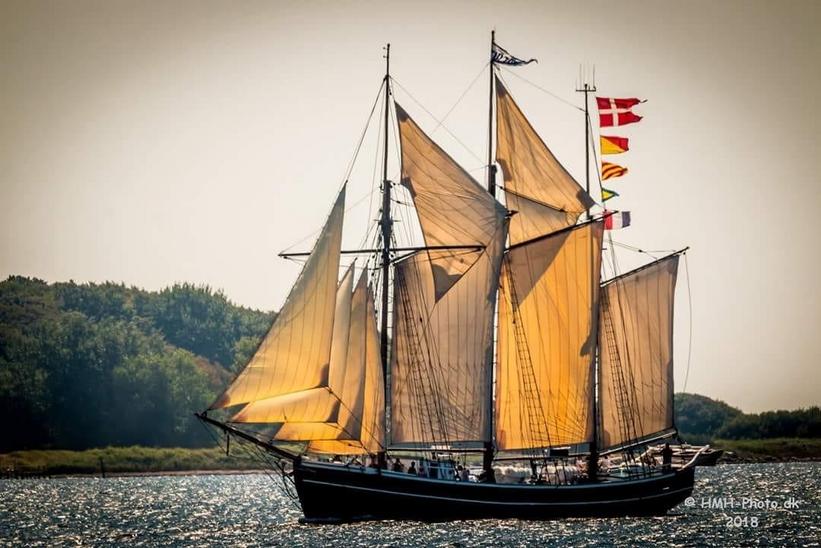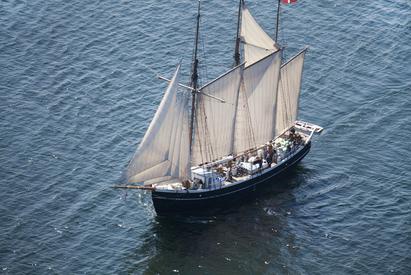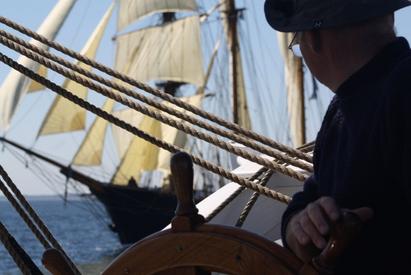
Fulton of Marstal
(3-mast schooner)
Cargo ship from 1915-1969
In the years leading up to World War I, the 4.000 inhabitants in the maritime town of Marstal, built, equipped and manned approx. 150-170 wooden ships. The sailing ships mainly moved cargo on the Atlantic and in European waters.
The story of Fulton started, when captain Marius Eriksen had the ship built in 1914-15 by shipbuilder Christian Ludvig Johansen for DKK 33,000. The ship was owned by a cooperative shipping company, where Marius Eriksen owed a third.
The launch of the ship on 26th of March 1915 in Marstal attracted a lot of people who followed the dramatic launch, where Fulton, due to low water, stalled halfway and had the rudder damaged.
Fulton moved cargo through two world wars until 1969. The first 8 years primarily dried, salted cod from Newfoundland to southern Europe. In 1923 the ship was sold to Sweden, but continued as cargo ship, mainly in the Baltic Sea area. In 1960, the ship returned to Denmark. Fulton’s last cargo was 159 tons of wheat, which was sailed from Nakskov to Aalborg. The grain was delivered the day before Christmas Eve in 1969. Afterwards Fulton was tied to the dock and put up for sale.
In the period from 1923-69, the ship was transformed from a sailing ship without an engine to a motor ship with a few sails.
The small Marstal schooners, such as Fulton, were nicknamed ‘Sparrows of the sea’ because they were numerous and always on a long voyage. These sailing ships carried goods around large parts of the world in the 1800s and early 1900s. Danish shipping today is based on the seamanship from these ships, where thousands of sailors on long voyages lived and worked on board under primitive conditions and in all kinds of weather.
Ship of youth since 1970
In the late 60s the large fleet of traditional Danish wooden ships quickly vanished. Some of the ships were sold abroad, while others were in very poor condition. The Danish National Museum wanted to preserve one of these ships for posterity and a donation of DKK 300,000 from the company Nilfisk to the National Museum ensured the future of Fulton in 1970.
Pictures, drawings and interviews with former crew members were found in Marstal, which made it possible to remake the ship’s rigging to its original appearance.
Unconventionally, it was decided that even though Fulton was owned by the museum, the ship should sail 5-7 days voyages with an ordinary school class on board. School classes still go on these voyages on Fulton today.
In addition, Fulton also became a ship which attracted a group of vulnerable young people, who experienced great benefit from becoming part of the community on board. Vulnerable youngsters have been a part of Fulton since 1970. Today, it is possible to stay on board Fulton for longer periods of time as an ‘Esbjerg Mate’, which is for young people, who needs a helping hand to find a good direction in life.
The organization ‘Fulton Fonden’ has since 2013 taken care of the operation of Fulton. For further information: https://fulton.dk/tall-ship/
Sailing trips on Fulton
The National Museum’s ship Fulton can be chartered for short trips by, for example, companies and associations.


Booking and enquiries
Jakob Jensen
Tel: 22 96 44 94
Email
